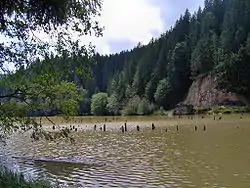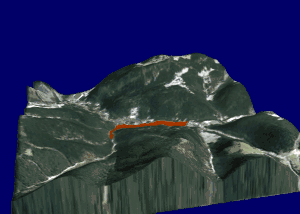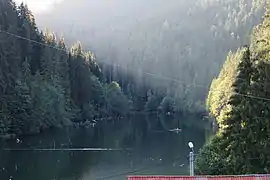Red Lake (Romania)
Red Lake (also known as Lake Ghilcoş; Hungarian: Gyilkos-tó or Veres-tó) is a natural dam lake formed following the collapse of a slope due to the earthquake of January 23, 1838 at 18:45, 6.9 magnitude, VIII intensity,[1] at the foot of Hasmasul Mare Mountain, near the Bicaz Gorge, at a distance of 26 km from Gheorgheni, in Harghita County. At the last measurements, made in 1987, its dimensions are: the lake lies on a perimeter of 2,830 m, the area is 114.676 m²[2] and the volume of water that accumulates is 587.503 m³. The lake was formed at an altitude of 983 m, in a depression with a predominant subalpine climate.
| Lacul Roșu | |
|---|---|
 | |
 Lacul Roșu | |
| Location | Eastern Carpathians |
| Coordinates | 46.78931°N 25.7869°E |
| Basin countries | Romania |
| Max. length | 8 kilometres (5.0 mi) |
| Max. width | 300 metres (980 ft) |
| Surface area | 11.47 hectares (28.3 acres) |
| Average depth | 9.7 m (32 ft) |
| Max. depth | 12.5 metres (41 ft) |
| Water volume | 587,500 cubic metres (476.3 acre⋅ft) |
| Surface elevation | 983 metres (3,225 ft) |

Location

The Red Lake is located between Suhardul Mic, Suhardul Mare on the north side, Southwest Podu Calului Mountains, Licaș Mountains and Kis-Havas Mountains in the northwest, Csíki-Bükk in the north-east and Muntele Ucigaș (The Killer Mount) in the eastern part. The lake is powered by four large streams and 12 temporary water courses, of which the most important are Verescheul (The Red), Licaş, Suhardul, Ucigașul(The Killer).
Lake formation
Although the Red Lake is a young formation, the conditions and time of the lake formation are very much discussed. During the forming, the lake area was a hardly accessible area, economically unexplored. According to Franz Herbich, Red Lake was formed in 1838. This is also justified by the earthquake of January 23, 1838, which was repeated in February and could have caused a landslide. Another year of forming is 1837, which can be argued by very violent storms and heavy rains. About this period writes Ditrói Puskás Ferenc in his work, "The History of Borsec". It is essential that the lake was formed by moving the clay mass deposited during the last ice age on the north-western slope of Mount Ghilcoş.
Soon after the valley had been closed, the fir forest was flooded, and the trees were petrified, giving a rare peculiarity to the whole landscape. In the first years of forming, the lake has expanded further - about a kilometer higher in the valley of the stream, but over time the natural dam eroded, the water level stabilizing at the current level.
Tourism
The surroundings of the lake have a pleasant microclimate, particularly beneficial for the treatment of physical and mental exhaustion, insomnia, neurasthenia. The average multiannual temperature is 8 °C, above the 6 °C average of the intramontane depressions. The valley is virtually free of winds, very clean air rich in natural aerosols, scenic surroundings provide excellent conditions for those who are seeking for sources of rapid regeneration naturally. Since the 1900s, it has been the recreational spa tourism that has brought development to the tourist services of this area.
See also
- Bicaz Canyon
- Cheile Bicazului-Hășmaș National Park
References
- Harta seismică a României
- Gheorghe Romanescu, Cristian Constantin Stoleriu and Andrei Enea Limnology of the Red Lake, Romania: An Interdisciplinary Study (2010), p. 47, at Google Books
External links
| Wikimedia Commons has media related to Red Lake (Romania). |

